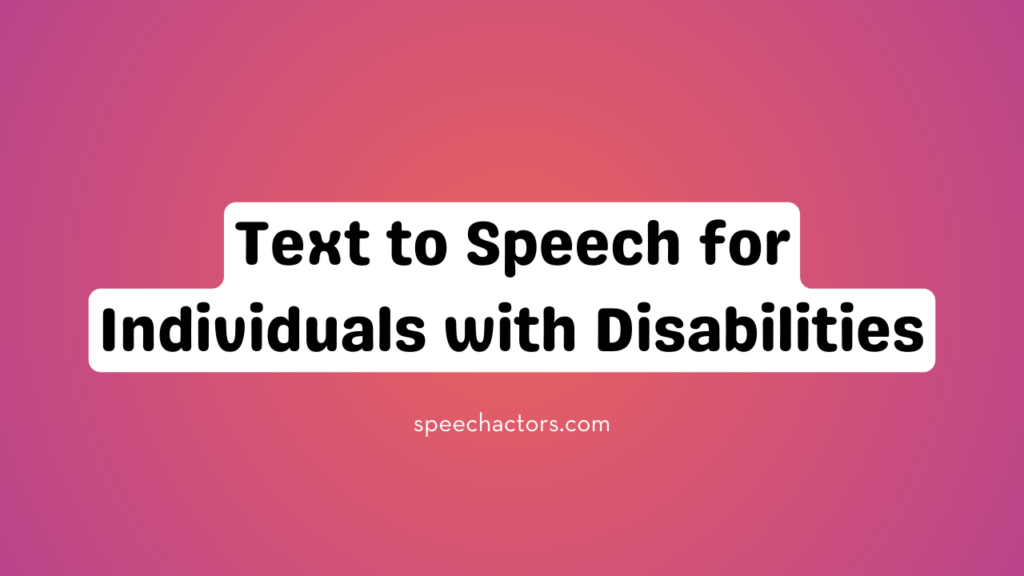Living with a disability can present numerous challenges, especially when it comes to communication and accessing information. Many individuals with disabilities struggle to read, write, or speak, which can limit their ability to participate fully in society and lead independent lives. These challenges can be frustrating and isolating, but there’s a solution that can help bridge the gap and empower individuals with disabilities to communicate more effectively.
In this article, we’ll explore how text to speech (TTS) technology is revolutionizing the lives of individuals with disabilities. We’ll discuss the benefits of using TTS as an assistive technology, how it works, and why tools like Speechactors are becoming essential for promoting accessibility and inclusion.
Challenges Faced by Individuals with Disabilities
Individuals with disabilities face a wide range of challenges when it comes to communication and accessing information. Here are some common barriers:
- Visual impairments that make reading difficult or impossible
- Speech disorders that limit verbal communication
- Cognitive impairments that affect language processing and comprehension
- Physical disabilities that restrict access to traditional communication methods
These challenges can lead to social isolation, limited educational and employment opportunities, and a reduced quality of life.
How Text to Speech Technology is Promoting Accessibility?
Text to speech technology uses artificial intelligence (AI) and natural language processing (NLP) to convert written text into human-like speech. Here’s how TTS is promoting accessibility for individuals with disabilities:
- Enabling independent access to information: TTS allows individuals with visual impairments or reading difficulties to listen to digital content, such as websites, documents, and e-books.
- Facilitating communication: TTS can be used as an augmentative and alternative communication (AAC) tool, helping individuals with speech disorders or physical disabilities to express themselves.
- Supporting language learning: TTS can assist individuals with language processing difficulties or those learning a new language by providing audio support and pronunciation guidance.
- Enhancing digital accessibility: TTS can be integrated into various digital platforms, such as websites and mobile apps, to make them more accessible and inclusive.
Benefits of Using Speechactors as an Assistive Technology
Speechactors is a powerful text to speech tool designed to support individuals with disabilities. With Speechactors, users can:
- Choose from a variety of natural-sounding voices in multiple languages
- Customize the speed, pitch, and tone of the generated speech
- Easily integrate the tool into their existing devices and software
- Access high-quality speech output for various purposes, such as reading, writing, and communication
- Save time and effort on tasks that would otherwise be challenging or impossible
Speechactors offers a user-friendly interface and seamless integration, making it easy for individuals with disabilities to incorporate TTS into their daily lives.
How to Use Text to Speech as an Assistive Technology?
Incorporating TTS into your life as an assistive technology is simple with tools like Speechactors. Here’s a step-by-step guide:
- Identify the content you want to convert to speech, such as a website, document, or e-book
- Input the text into the Speechactors tool or use the browser extension to read web content aloud
- Select the desired voice, language, and customization options
- Listen to the generated speech and adjust the settings as needed
- Use the speech output for reading, writing, communication, or any other purpose that supports your needs and goals
By using TTS technology, individuals with disabilities can access information, express themselves, and participate more fully in various aspects of life.
Conclusion
Text to speech technology is empowering individuals with disabilities to overcome communication barriers and access information more independently. By leveraging the power of AI and natural language processing, TTS tools like Speechactors are promoting accessibility, inclusion, and equal opportunities for people with a wide range of disabilities.
With the ability to customize voices, support multiple languages, and integrate seamlessly with existing devices and software, TTS is becoming an essential assistive technology for individuals looking to lead more independent and fulfilling lives. By embracing TTS technology and tools like Speechactors, we can create a more inclusive and accessible world, where everyone has the opportunity to communicate, learn, and thrive.
